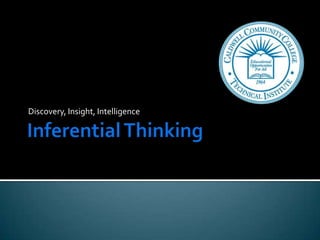The Art Of Inference
•Transferir como PPTX, PDF•
2 gostaram•1,175 visualizações
The introductory presentation used to train people in the "Art of Inference". Join the William\'s Inference Service group to learn more.
Denunciar
Compartilhar
Denunciar
Compartilhar

Recomendados
Recomendados
Mais conteúdo relacionado
Semelhante a The Art Of Inference
Semelhante a The Art Of Inference (20)
Handout for "Proven Presentation Techniques", an InfoComm approved workshop b...

Handout for "Proven Presentation Techniques", an InfoComm approved workshop b...
Mpu1024 week13 analysis dR BAMBANAG SUMINTONO- by abdul murad abd hamid

Mpu1024 week13 analysis dR BAMBANAG SUMINTONO- by abdul murad abd hamid
Unfinished Business Workshop: Working with user research data

Unfinished Business Workshop: Working with user research data
The Art Of Inference
- 1. Inferential Thinking Discovery, Insight, Intelligence
- 2. Agenda 1:30 pm Welcome and Introductions Collecting anomalies - the foundation of inference - What to collect - defining the characteristics of useful anomalies. - How to observe anomalies while scanning the business environment. Group work sessions – In groups of 3 to 5 we will investigate a selection of current Williams themes in depth. 3 – 3.20 pm Afternoon Tea/Coffee Weaving – Groups practice pulling the pieces together and drawing inferences - Finding the context of change – careful use of historical perspective - The use of symbols - The use of research (uncovering the unintended message) Using discoveries Questions/Discussion 4:30 pm Adjourn
- 4. Inferring from a limited data set and recognizing patterns of change
- 5. Monitoring, testing and strengthening hypotheses using targeted research
- 8. Observation “It is not what you look at, but rather what you see.” Henry David Thoreau Danger and Opportunity The “new” has no experts Old knowledge can be a hindrance Minimize the data so decisions are more accurate
- 10. Surprises – growth more than 20%, outpacing a leader, unintended messages
- 11. Firsts – the beginning of change.
- 12. Lies and deceit – strengthen significance
- 14. Anecdotes Led by anomaly and symbol Observations in one instance can be extrapolated to a larger cultural significance Important to stimulate creative response to an inference Emerge from discussion and relationships
- 15. Inferences Making hypotheses beyond cause/effect relationships Inclusive of an awareness of the relative danger/opportunity Need a broad perspective, yet a specific lens (limited data set) Early warning, predictive, but not timed Corollaries often surface with time
- 17. Inferential thinking is a means to see through the clutter of information overload
- 18. Try to use only a few pieces of information to make key decisions
- 19. Base decisions on inferences rather than history alone
- 20. History is useful in the development of the “gut feeling”
- 21. Inferential training helps professionals gain sufficient confidence to achieve accuracy ahead of the curve
- 23. Unintended messages looking for an insight
- 24. Design
- 25. An insight looking for options
- 26. Choice
- 27. Selecting an option and taking action
- 28. Review